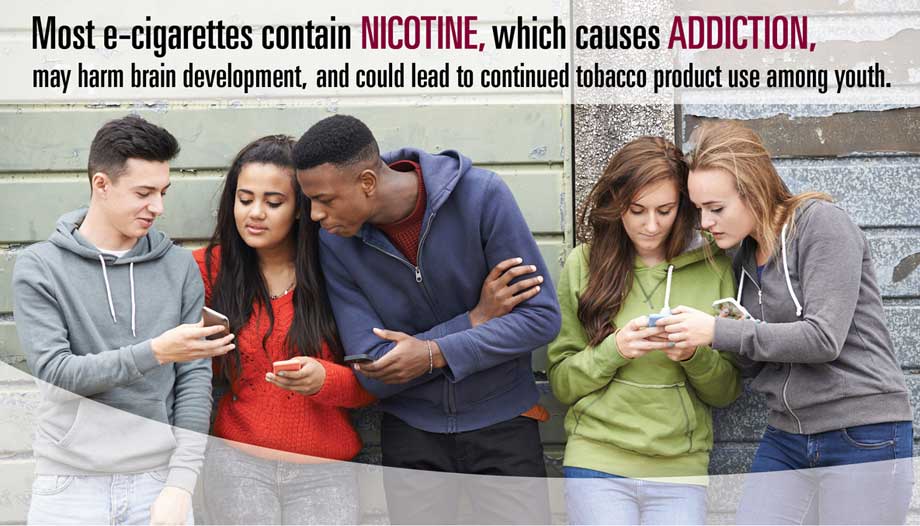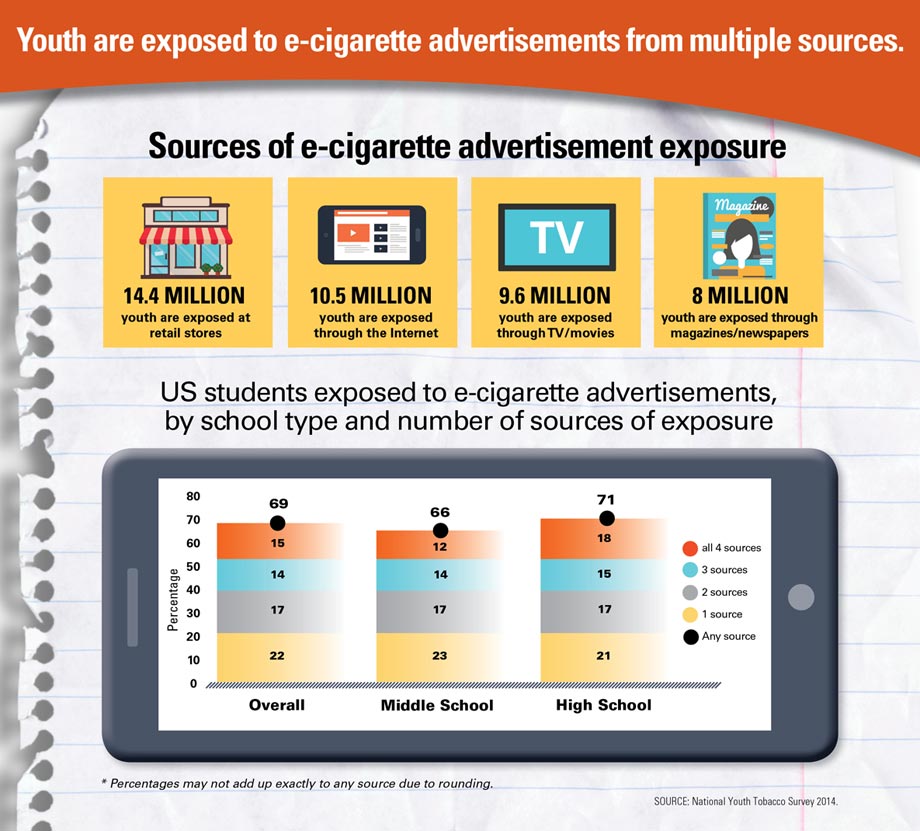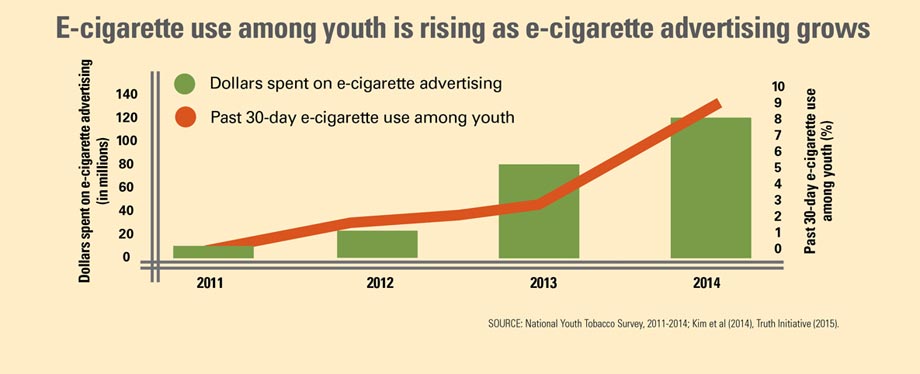E-cigarette Ads and Youth
Overview
About 2.4 million middle and high school students were current (past 30-day) users of electronic cigarettes, or e-cigarettes, in 2014. Most e-cigarettes contain nicotine, which causes addiction, may harm brain development, and could lead to continued tobacco product use among youth. Tobacco product advertising can entice youth to use tobacco, and spending to advertise e-cigarettes has increased rapidly since 2011. About 69% of middle and high school students were exposed to e-cigarette advertisements in retail stores, on the Internet, in magazines/newspapers, or on TV/movies. Exposure to e-cigarette advertisements may be contributing to increases in e-cigarette use among youth. Efforts by states, communities, and others could reduce this exposure.
States and communities can:
- Fund tobacco prevention and control programs at CDC-recommended levels to prevent youth use of all tobacco products, including e-cigarettes.
- Work to limit where and how all tobacco products, including e-cigarettes, are sold to reduce youth e-cigarette use, as well as ad exposure.
- Support efforts to implement and sustain proven youth tobacco prevention actions such as tobacco price increases, comprehensive smoke-free laws, and high-impact mass media campaigns.


More than 18 million (7 in 10) US middle and high school youth were exposed to e-cigarette ads in 2014.
More than 1 in 2 middle and high school youth were exposed to e-cigarette ads in retail stores.
Nearly 2 in 5 middle and high school youth saw e-cigarette ads online.
Problem
Youth are vulnerable to e-cigarette ads.
18 million youth were exposed to e-cigarette ads in 2014.
- More than 10 million high school students and nearly 8 million middle school students were exposed to e-cigarette ads in 2014.
- More than half of high school students (about 8 million) saw e-cigarette ads in retail stores, and more than 6 million saw them on the Internet.
- More than half of middle school students (6 million) saw e-cigarettes ads in retail stores, and more than 4 million saw them on the Internet.
- About 15% of all students reported seeing e-cigarette ads from all four sources, including retail stores, the Internet, magazines/newspapers, and TV/movies.
Exposure to e-cigarette ads may contribute to youth e-cigarette use:
- E-cigarette companies have rapidly increased advertising spending, from $6.4 million in 2011 to $115 million in 2014.
- Many of the themes used in advertising for cigarettes are also now used to advertise e-cigarettes – including sex, independence, and rebellion.
- During the time e-cigarette ads have increased, there are also increases in e-cigarette use among US youth. From 2011-2014, e-cigarette use in the past 30 days increased from less than 1% to almost 4% among middle school students and from less than 2% to 13% among high school students.

View large image and text description

View larger image and text description

View larger image and text description
What Can Be Done?
The Federal government is
- Supporting state tobacco prevention and control programs to prevent any youth use of tobacco products, including e-cigarettes.
- Tracking e-cigarette use; supporting research on the health effects and factors contributing to youth e-cigarette use; and providing information to the public, including health care providers.
- Developing regulations for e-cigarettes and other currently unregulated tobacco products to reduce the disease and death from tobacco use, including by preventing youth tobacco use.
- Funding and promoting campaigns that inform people about the dangers of tobacco use, such as FDA's The Real Cost and Fresh Empire for youth and CDC's Tips From Former Smokers for adults.
States and communities can
- Fund tobacco prevention and control programs at CDC-recommended levels to prevent youth use of all tobacco products, including e-cigarettes.
- Work to limit where and how all tobacco products, including e-cigarettes, are sold to reduce youth e-cigarette use, as well as ad exposure. This may include:
- Requiring age verification to enter e-cigarette vendors' websites, make purchases, and accept deliveries of e-cigarettes.
- Restricting the number of stores that sell tobacco and how close they can be to schools.
- Requiring that e-cigarettes be sold only through face-to-face transactions, not on the Internet.
- Limiting tobacco product sales to facilities that never admit youth.
- Support efforts to implement and continue proven youth tobacco prevention approaches, including tobacco price increases, comprehensive smoke-free laws, and high-impact mass media campaigns.
Pediatricians, nurses, and other health care providers can
- Ask about youths' e-cigarette use and counsel them about the dangers of nicotine, e-cigarettes, and all other tobacco use.
- Ask all patients whether they use tobacco products, encourage those who do to quit, and provide help with quitting.
- Ask about youths' media and Internet use. Advise parents and caregivers to take an active role in deciding which websites and media children may view and teaching critical viewing skills.
Parents and caregivers can
- Set a positive example by being tobacco-free. For free help, call 1-800-QUIT-NOW or visit www.smokefree.gov
- Talk to youth about why they shouldn't use any tobacco products, including e-cigarettes.
- Know what media their children are viewing, and decide what programs and websites are appropriate for their age. Watch programs together and discuss content.
- Vital Signs Issue details: Exposure to Electronic Cigarette Advertising Among Middle School and High School Students — United States, 2014, Morbidity and Mortality Weekly Report (MMWR)
- Vital Signs – E-cigarette Ads and Youth [PODCAST - 1:15 minutes]
- Vital Signs – E-cigarette Ads and Youth [PSA - 0:60 seconds]
- Preventing Tobacco Use Among Youth and Young Adults: A Report of the Surgeon General, 2012
- CDC's Best Practices for Comprehensive Tobacco Control Programs—2014
- 2014 Surgeon General's Report: The Health Consequences of Smoking—50 Years of Progress
- Electronic Nicotine Delivery Systems: Key Facts, May 2016[374KB]
- CDC's Office on Smoking and Health E-cigarette Information, Nov 2015[63KB]
- Tobacco Use Among Middle and High School Students – United States, 2011 – 2014





















.png)












No hay comentarios:
Publicar un comentario